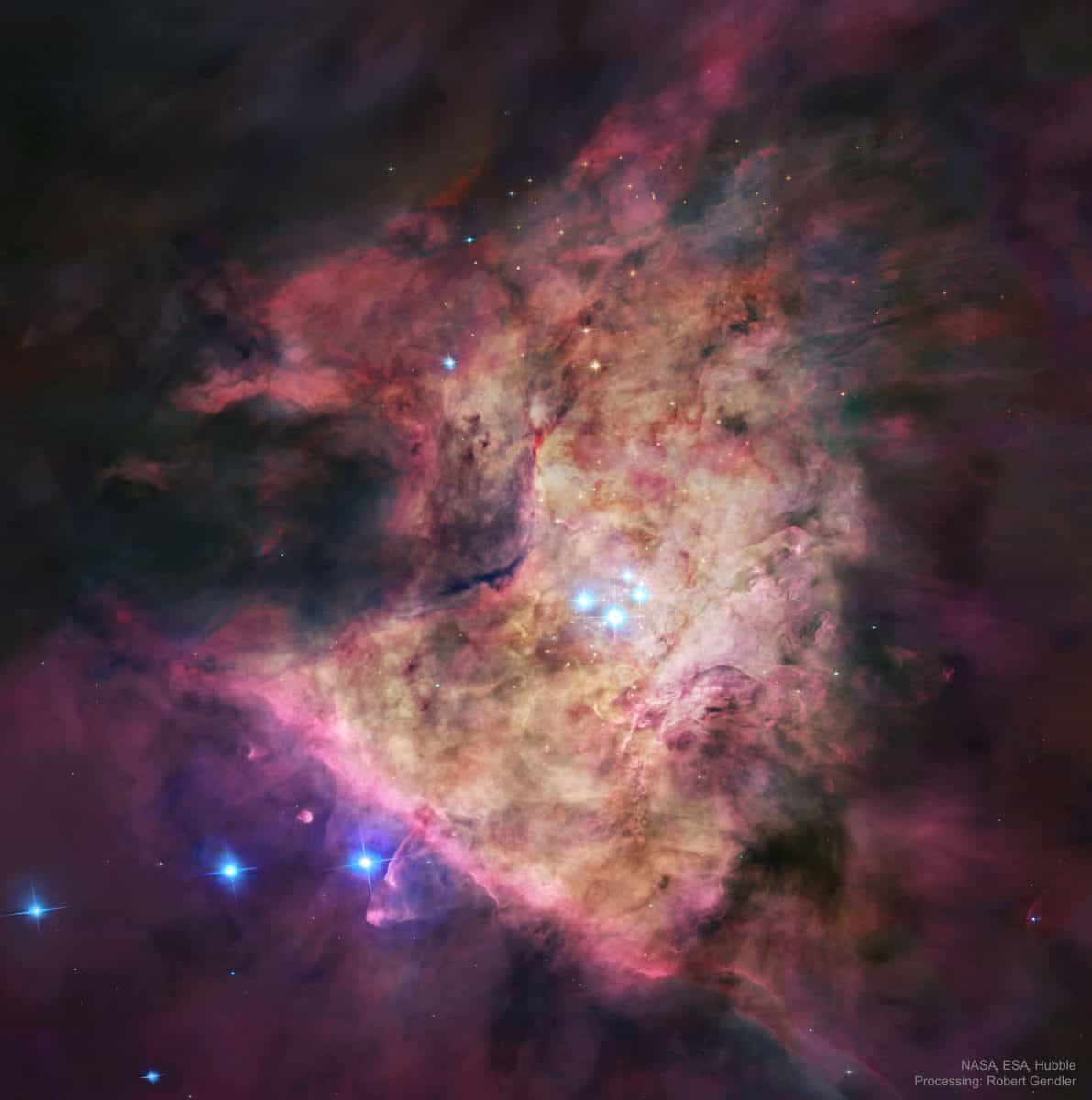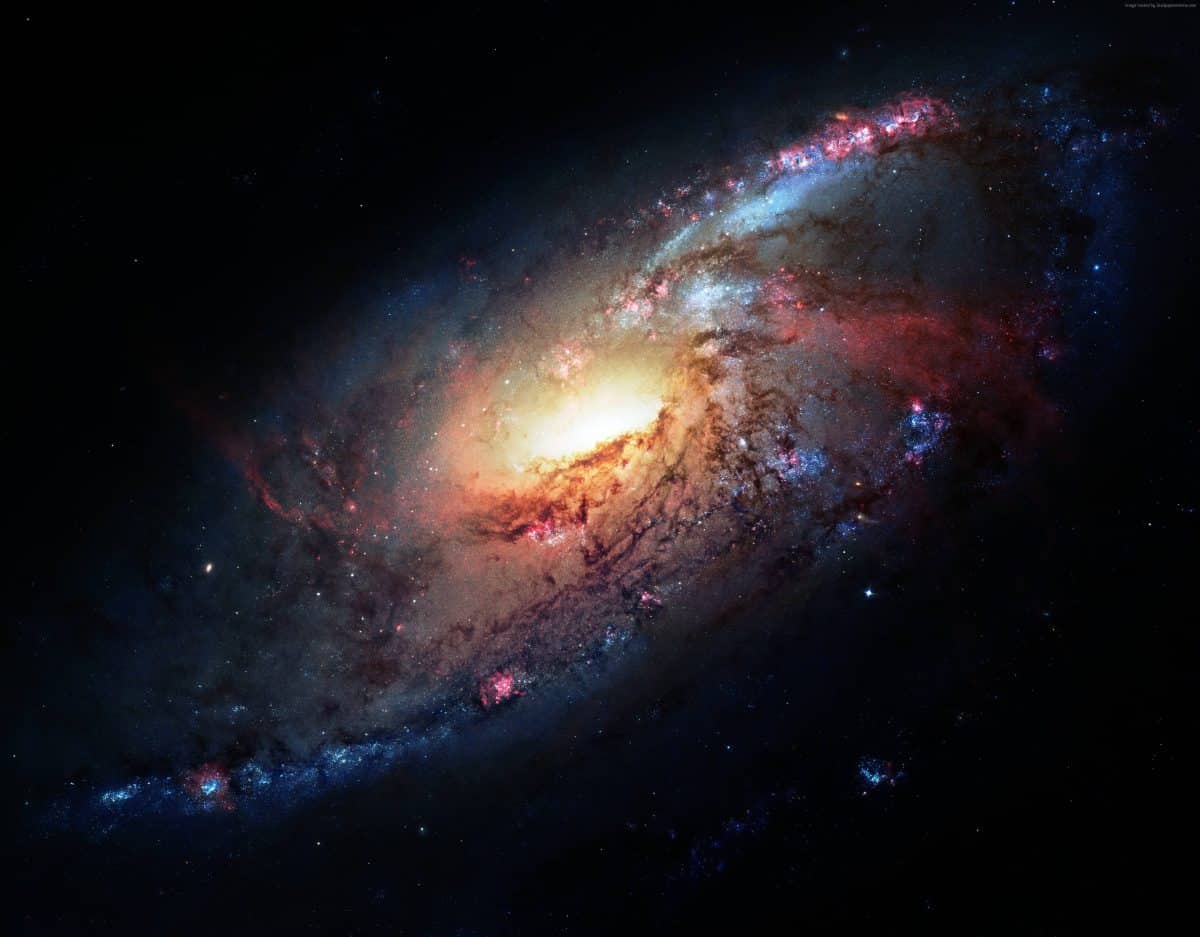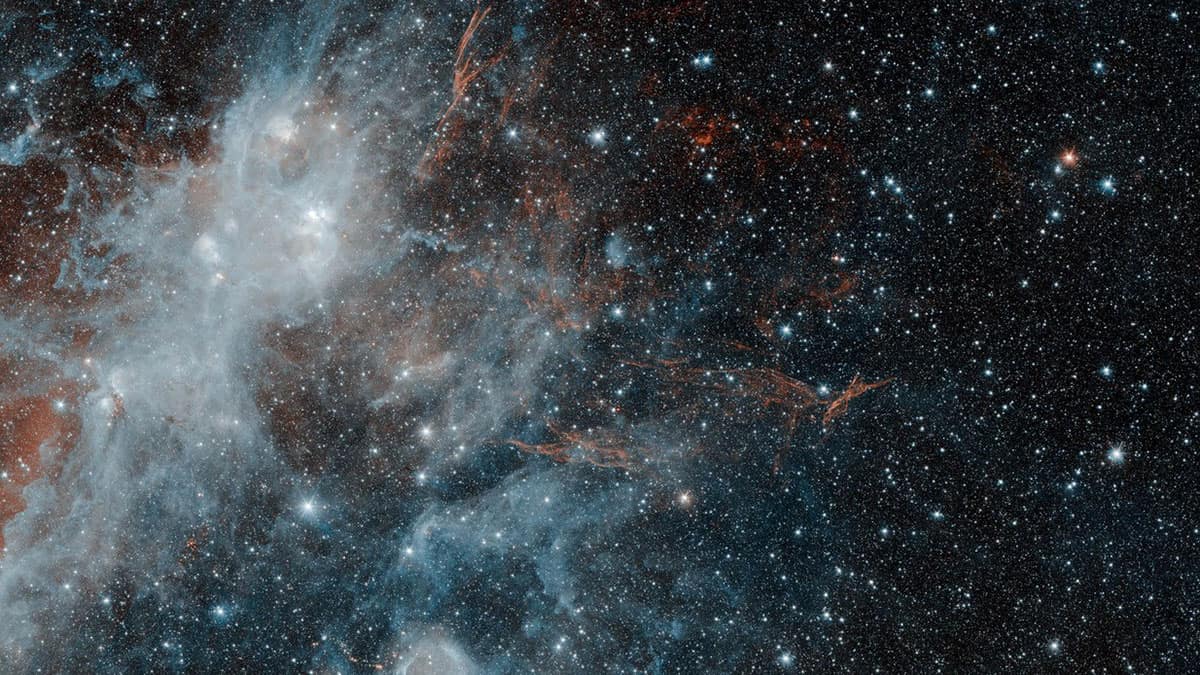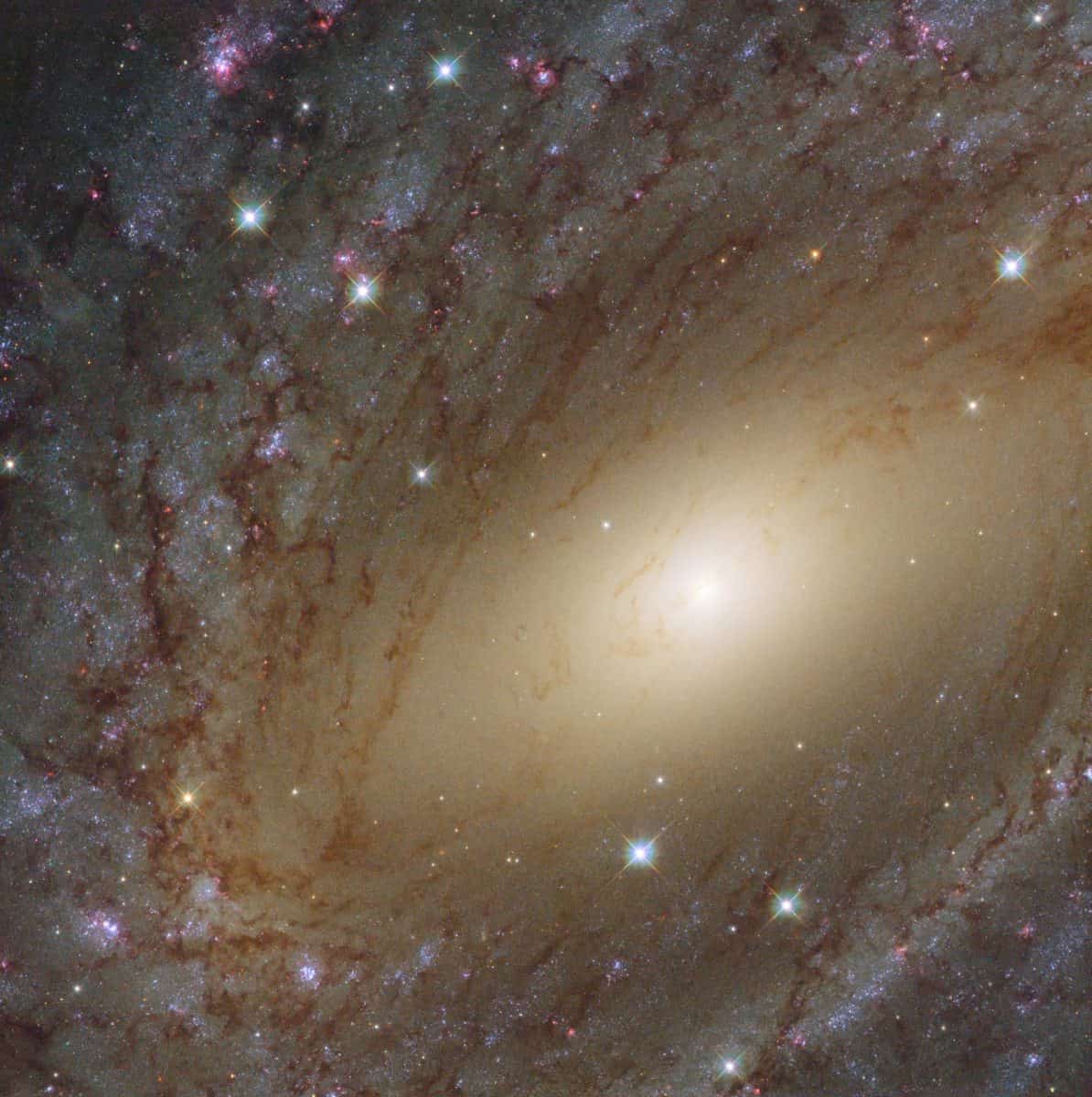Blog
Near the center of this sharp cosmic portrait, at the heart of the Orion Nebula, are four hot, massive stars known as the Trapezium. Gathered within a region about 1.5 light-years in radius, they dominate the core of the dense Orion Nebula Star Cluster. Ultraviolet ionizing radiation from the Trapezium stars, mostly from the brightest star Theta-1 Orionis C powers the complex star forming region’s entire visible glow. About three million years old, the Orion Nebula Cluster was even more compact in its younger years and a recent dynamical study indicates that runaway stellar collisions at an earlier age may have formed a black hole with more than 100 times the mass of the Sun. The presence of a black hole within the cluster could explain the observed high velocities of the Trapezium stars. The Orion Nebula’s distance of some 1,500 light-years would make it the closest known black hole to planet Earth.
more...Airto Moreira (born August 5, 1941) is a Brazilian jazz drummer and percussionist. He is married to jazz singer Flora Purim, and their daughter Diana Moreira is also a singer.
Airto Moreira was born in Itaiópolis, Brazil, into a family of folk healers, and raised in Curitiba and São Paulo. Showing an extraordinary talent for music at a young age, he became a professional musician at age 13, noticed first as a member of the samba jazz pioneers Sambalanço Trio and for his landmark recording with Hermeto Pascoal in Quarteto Novo in 1967. Shortly after, he followed his wife Flora Purim to the United States.
After moving to the US, Moreira began playing regularly with jazz musicians in New York, including the bassist Walter Booker. Through Booker, Moreira began playing with Joe Zawinul, who in turn introduced him to Miles Davis. At this time Davis was experimenting with electronic instruments and rock and funk rhythms, a form which would soon come to be called jazz fusion. Moreira was to participate in several of the most important projects of this emerging musical form. He stayed with Davis for about two years, touring and participating in the creation of the seminal fusion recording Bitches Brew (1970).
https://www.youtube.com/watch?v=UV8-x8UZOo0
more...
Leonard Harold Breau (August 5, 1941 – August 12, 1984) was an American-born guitarist and music educator. Breau blended many styles of music, including jazz, country, classical, and flamenco. Inspired by country guitarists like Chet Atkins, Breau used fingerstyle techniques not often used in jazz guitar. By using a seven-string guitar and approaching the guitar like a piano, he opened up possibilities for the instrument.
Breau was born August 5, 1941, in Auburn, Maine, but moved with his family to Moncton, New Brunswick in 1948.
Around 1959 Breau left his parents’ country band after his father slapped him in the face for incorporating jazz improvisation into his playing with the group. He sought out local jazz musicians, performing at Winnipeg venues Rando Manor and the Stage Door. He met pianist Bob Erlendson, who began teaching him more of the foundations of jazz. In 1962, Breau left for Toronto and created the jazz group Three with singer and actor Don Francks, and Eon Henstridge on acoustic bass.
Three performed in Toronto, Ottawa, and New York City. Their music was featured in the 1962 National Film Board documentary Toronto Jazz. They recorded a live album at the Village Vanguard in New York City and appeared on the Jackie Gleason and Joey Bishop television shows. Returning to Winnipeg, Breau became a session guitarist, recording for CBC Radio and CBC Television, and contributed to CBC-TV’s Teenbeat, Music Hop, and his own The Lenny Breau Show.
more...Pandit Kumar Bose was born April 4, 1953. He is one of India’s most respected and skilled tabla players. He is the most established disciple of the legendary maestro, Pandit Kishan Maharaj, belonging to the Benares gharana (school) of tabla playing, and is equally regarded for his tabla solo recitals as well as his accompaniment. Kumar Bose has performed and recorded with some of the greatest Indian musicians, including Ravi Shankar.
more...A spiral galaxy with a secret The NASA/ESA Hubble Space Telescope – with a little help from an amateur astronomer – has produced one of the best views yet of nearby spiral galaxy Messier 106. Located a little over 20 million light-years away, practically a neighbour by cosmic standards, Messier 106 is one of the brightest and nearest spiral galaxies to our own. Despite its appearance, which looks much like countless other galaxies, Messier 106 hides a number of secrets. Thanks to this image, which combines data from Hubble with observations by amateur astronomers Robert Gendler and Jay GaBany, they are revealed as never before. At its heart, as in most spiral galaxies, is a supermassive black hole, but this one is particularly active. Unlike the black hole at the centre of the Milky Way, which pulls in wisps of gas only occasionally, Messier 106’s black hole is actively gobbling up material. As the gas spirals towards the black hole, it heats up and emits powerful radiation. Part of the emission from the centre of Messier 106 is produced by a process that is somewhat similar to that in a laser – although here the process produces bright microwave radiation.[1] As well as this microwave emission from Messier 106’s heart, the galaxy has another startling feature – instead of two spiral arms, it appears to have four. Although the second pair of arms can be seen in visible light images as ghostly wisps of gas, as in this image, they are even more prominent in observations made outside of the visible spectrum, such as those using X-ray or radio waves. Unlike the normal arms, these two extra arms are made up of hot gas rather than stars, and their origin remained unexplained until recently. Astronomers think that these, like the microwave emission from the galactic centre, are caused by the black hole at Messier 106’s heart, and so are a totally different phenomenon from the galaxy’s normal, star-filled arms. The extra arms appear to be an indirect result of jets of material produced by the violent churning of matter around the black hole. As these jets travel through the galactic matter they disrupt and heat up the surrounding gas, which in turn excites the denser gas in the galactic plane and causes it to glow brightly. This denser gas closer to the centre of the galaxy is tightly-bound, and so the arms appear to be straight. However, the looser disc gas further out is blown above or below the disc in the opposite direction from the jet, so that the gas curves out of the disc — producing the arching red arms seen here. Despite carrying his name, Messier 106 was neither discovered nor catalogued by the renowned 18th century astronomer Charles Messier. Discovered by his assistant, Pierre Méchain, the galaxy was never added to the catalogue in his lifetime. Along with six other objects discovered but not logged by the pair, Messier 106 was posthumously added to the Messier catalogue in the 20th century. Amateur astronomer Robert Gendler retrieved archival Hubble images of M 106 to assemble a mosaic of the centre of the galaxy. He then used his own and fellow astrophotographer Jay GaBany’s observations of M 106 to combine with the Hubble data in areas where there was less coverage, and finally, to fill in the holes and gaps where no Hubble data existed. The centre of the galaxy is composed almost entirely of Hubble data taken by the Advanced Camera for Surveys, Wide Field Camera 3, and Wide Field and Planetary Camera 2 detectors. The outer spiral arms are predominantly HST data colourised with ground-based data taken by Gendler’s and GaBany’s 12.5-inch and 20-inch telescopes, located at very dark remote sites in New Mexico, USA. Gendler was a prizewinner in the recent Hubble’s Hidden Treasures image processing competition. Another prizewinner, André van der Hoeven, entered a different version of Messier 106, combining Hubble and NOAO data. About the Object: Name: M 106 Type: • Local Universe : Galaxy : Type : Spiral • Galaxies Images/Videos Distance: 20 million light years Colours & filters: Band Wavelength Telescope Infrared I 814 nm Hubble Space Telescope ACS Infrared I 814 nm Hubble Space Telescope WFC3 Optical H-alpha 656 nm Hubble Space Telescope WFPC2 Optical V 555 nm Hubble Space Telescope ACS Optical V 606 nm Hubble Space Telescope ACS Optical V 555 nm Hubble Space Telescope WFC3 Optical B 435 nm Hubble Space Telescope ACS Footnotes ↑ Lasers work when light stimulates emission of more light from a cloud of excited gas, with the original light in effect being amplified (the word laser is an acronym for light amplification by the stimulated emission of radiation). The centre of M106 harbours a similar phenomenon called a maser (short for microwave amplification by the stimulated emission of radiation), in which microwave radiation, which is at longer wavelengths than visible light, is emitted. Note that unlike man-made lasers, which are designed to produce a narrow beam, astronomical masers shine in all directions.
more...
Mitchell Herbert Ellis (August 4, 1921 – March 28, 2010) was an American jazz guitarist. Perhaps best known for his 1950s membership in the trio of pianist Oscar Peterson, Ellis was also a staple of west-coast studio recording sessions, and was described by critic Scott Yanow as “an excellent bop-based guitarist with a slight country twang to his sound.”
Born in Farmersville, Texas and raised in the suburbs of Dallas, Ellis first heard the electric guitar performed by George Barnes on a radio program. This experience is said to have inspired him to take up the guitar. He became proficient on the instrument by the time he entered North Texas State University. Ellis majored in music, but because they did not yet have a guitar program at that time, he studied the string bass. Unfortunately, due to lack of funds, his college days were short-lived. In 1941, Ellis dropped out of college and toured for six months with a band from the University of Kansas.
more...Louis Daniel Armstrong (August 4, 1901 – July 6, 1971), nicknamed Satchmo, Satch, and Pops, was an American trumpeter, composer, singer and occasional actor who was one of the most influential figures in jazz. His career spanned five decades, from the 1920s to the 1960s, and different eras in the history of jazz. In 2017, he was inducted into the Rhythm & Blues Hall of Fame.
Armstrong was born and raised in New Orleans. Coming to prominence in the 1920s as an “inventive” trumpet and cornet player, Armstrong was a foundational influence in jazz, shifting the focus of the music from collective improvisation to solo performance. Around 1922, he followed his mentor, Joe “King” Oliver, to Chicago to play in the Creole Jazz Band. In the Windy City, he networked with other jazz musicians, reconnecting with his friend, Bix Beiderbecke, and made new contacts, which included Hoagy Carmichael and Lil Hardin. He earned a reputation at “cutting contests”, and moved to New York in order to join Fletcher Henderson‘s band.
With his instantly recognizable gravelly voice, Armstrong was also an influential singer, demonstrating great dexterity as an improviser, bending the lyrics and melody of a song for expressive purposes. He was also very skilled at scat singing. Armstrong is renowned for his charismatic stage presence and voice almost as much as for his trumpet playing. Armstrong’s influence extends well beyond jazz, and by the end of his career in the 1960s, he was widely regarded as a profound influence on popular music in general. Armstrong was one of the first truly popular African-Americanentertainers to “cross over,” that is, whose skin color became secondary to his music in an America that was extremely racially divided at the time. He rarely publicly politicized his race, often to the dismay of fellow African Americans, but took a well-publicized stand for desegregation in the Little Rock crisis. His artistry and personality allowed him access to the upper echelons of American society, then highly restricted for black men.
Armstrong often stated that he was born on July 4, 1900. Although he died in 1971, it was not until the mid-1980s that his true birth date, August 4, 1901, was discovered by Tad Jones by researching baptismal records. At least three other biographies treat the July 4th birth date as a myth.
more...https://www.youtube.com/watch?v=JyUMZ4Tpp0U
more...Thin, red veins of energized gas mark the location of one of the larger supernova remnants in the Milky Way galaxy in this image from NASA’s Spitzer Space Telescope.
A supernova “remnant” refers to the collective, leftover signs of an exploded star, or supernova. The red filaments in this image belong to a supernova remnant known as HBH 3 that was first observed in 1966 using radio telescopes. Traces of the remnant also radiate optical light. The branches of glowing material are most likely molecular gas that was pummeled by a shockwave generated by the supernova. The energy from the explosion energized the molecules and caused them to radiate infrared light.
The white, cloud-like formation also visible in the image is part of a complex of star-forming regions, simply named W3, W4 and W5. However, those regions extend far beyond the edge of this image. Both the white star-forming regions and the red filaments are approximately 6,400 light years away and lie inside our Milky Way galaxy.
HBH 3 is about 150 light-years in diameter, ranking it amongst the largest known supernova remnants. It is also possibly one of the oldest: Astronomers estimate the original explosion may have happened anywhere from 80,000 to one million years ago.
In 2016, NASA’s Fermi Gamma-Ray Telescope detected very high-energy light — called gamma rays — coming from the region near HBH 3. This emission may be coming from gas in one of the neighboring star-forming regions, excited by powerful particles emitted by the supernova blast.
more...Roscoe Mitchell (born August 3, 1940) is an American composer, jazz instrumentalist, and educator, known for being “a technically superb – if idiosyncratic – saxophonist”. The Penguin Guide to Jazz described him as “one of the key figures” in avant-garde jazz; All About Jazz states that he has been “at the forefront of modern music” for the past 35 years. Critic Jon Pareles in The New York Times has mentioned that Mitchell “qualifies as an iconoclast”. In addition to his own work as a bandleader, Mitchell is known for cofounding the Art Ensemble of Chicago and the Association for the Advancement of Creative Musicians (AACM).
Mitchell was born in Chicago, Illinois. He also grew up in the Chicago area, where he played saxophone and clarinet at around age twelve. His family was always involved in music with many different styles playing in the house when he was a child as well as having a secular music background. His brother, Norman, in particular was the one who introduced Mitchell to jazz. While attending Englewood High School in Chicago, he furthered his study of the clarinet.
https://www.youtube.com/watch?v=perVFDDy_xg
more...Charles James Shavers (August 3, 1920 – July 8, 1971) was an American swing era jazz trumpeter who played with Dizzy Gillespie, Roy Eldridge, Johnny Dodds, Jimmie Noone, Sidney Bechet, Midge Williams, and Billie Holiday. He was an arranger and composer, and one of his compositions, “Undecided“, is a jazz standard.[2]
Charlie Shavers’ father (a distant relative of Fats Navarro) was from the prominent Shavers family of Key West, Florida, and Charlie was a cousin of heavyweight boxer Earnie Shavers. Born in New York City, he took up piano and banjo before switching to trumpet.
more...Eddie Jefferson (August 3, 1918 – May 9, 1979) was a jazz vocalist and lyricist. He is credited as an innovator of vocalese, a musical style in which lyrics are set to an instrumental composition or solo. Jefferson himself claims that his main influence was Leo Watson. Perhaps his best-known song is “Moody’s Mood for Love“, though it was first recorded by King Pleasure, who cited Jefferson as an influence. Jefferson’s songs “Parker’s Mood” and “Filthy McNasty” were also hits.
Jefferson was born in Pittsburgh, Pennsylvania. One of his most notable recordings, “So What“, combined the lyrics of artist Christopher Acemandese Hall with the music of Miles Davis to highlight his skills, and enabled him to turn a phrase, into his style he calls jazz vocalese.
https://www.youtube.com/watch?v=ecYDByed7z8
more...World Music on Flamenco Fridays with Paco de Lucia and Ricardo Modrego
Ricardo Modrego (19 October 1934 – 17 January 2017) was a Spanish flamenco guitarist from Madrid. He was the brother of Spanish-Flamenco dancer Nana Lorca. They both started their careers in Madrid in the early 1950s.
By 1953 the well known brother and sister were under contract to tour South America with Spanish dancer Hurtado de Cordoba. In October 1954 the Cordoba Company debut at the 48th Street Theatre in New York to good reviews and poor ticket sales. The four-week contract played out for only two weeks. The brother and sister team found temporary work in the US but soon returned to Spain. In Madrid they auditioned for Pilar Lopez and joined her company touring in Spain and internationally. Ricardo recorded three albums with a young Paco de Lucia, his first albums, Dos guitarras flamencas (1964), 12 canciones de García Lorca para guitarra and 12 éxitos para 2 guitarras flamencas (1965). In between the records the brother and sister team toured with the Jose Greco Spanish Dance Company. Nana later married Jose Greco and both Greco’s toured the world as famous Spanish-Flamenco dancers. Ricardo also toured with Mariemma and Antonio Ruiz, he joined the Greco’s on tour from time to time. Jose and Nana had one son Paolo Greco, a film music composer. The Greco’s divorced leaving both Nana Lorca and Paolo Greco to live in Madrid.
more...NGC 6744 is situated in the constellation of Pavo at a distance of about 25 million light-years.
It was discovered in June 1826 by the British astronomer James Dunlop.
At first glance, it resembles our Milky Way Galaxy albeit larger, measuring more than 200,000 light-years across compared to 100,000 light-year diameter for our Galaxy.
NGC 6744 is similar to the Milky Way in more ways than one.
Like our home Galaxy, it has a prominent central region packed with old yellow stars.
Moving away from NGC 6744’s galactic core, we can see parts of the dusty spiral arms painted in shades of pink and blue.
While the blue sites are full of young star clusters, the pink ones are regions of active star formation, indicating that the galaxy is still very lively.
In 2005, a supernova — named SN 2005at — was discovered within NGC 6744, adding to the argument of this galaxy’s liveliness.
SN 2005at is a type Ic supernova, formed when a massive star collapses in itself and loses its hydrogen envelope.
This image of NGC 6744 was taken by Hubble’s Wide Field Camera 3 (WFC3) as part of the Legacy ExtraGalactic UV Survey (LEGUS), the most comprehensive ultraviolet-light survey of nearby star-forming galaxies.
This survey will help astronomers interpret views of galaxies in the distant Universe, where the ultraviolet glow from young stars is stretched to infrared wavelengths due to the expansion of space.
Juvenal de Holanda Vasconcelos, known as Naná Vasconcelos (2 August 1944 – 9 March 2016), was a Brazilian percussionist, vocalist and berimbau player, notable for his work as a solo artist on over two dozen albums, and as a backing musician with Pat Metheny, Don Cherry, Jan Garbarek, Egberto Gismonti, Gato Barbieri, and Milton Nascimento.
more...Carl Saunders (born August 2, 1942) is a jazz trumpeter, composer, and educator who has worked with Stan Kenton, Buddy Rich, Bill Holman, and Clare Fischer, in addition to Frank Sinatra, Ella Fitzgerald, Mel Tormé, and Paul Anka.
Born in Indianapolis, Indiana, his first five years were mostly spent on the road. His uncle was trumpeter Bobby Sherwood, who was led the popular Sherwood Orchestra, having hits with “Elks Parade” and “Sherwood’s Forest.” Saunders’s mother Gail (Bobby’s sister) sang for the Sherwood Orchestra and Stan Kenton. When Saunders was five, he and his mother settled in Los Angeles, living with his aunt Caroline and her husband, saxophonist Dave Pell. He heard the records of the Dave Pell Octet and was influenced by the style and phrasing of trumpeter Don Fagerquist.
more...Faenza Codex instrumental music of the 15th c with Ensemble Unicorn & Michael Posch
https://www.youtube.com/watch?v=t-TxpEeE4qs
more...More Posts
- World Music with Paco De Lucia
- Daily Roots with Alton Ellis & the Heptones
- The Cosmos with Sharpless 2-106
- John Medeski Day
- David Honeyboy Edwards Day
- World Music with Odpoczno
- Daily Roots with Ras Tweed
- The Cosmos with M8
- Johnny “Big Moose” Walker Day
- Elmo Hope Day
- Shad Collins Day
- World Music with Eleftheria Arvanitaki
- Daily Roots with Israel Vibration
- The Cosmos with NGC 1187
- Reggie Workman Day
- Big Bill Broonzy Day
- World Music with Very Be Careful
- Daily Roots with Uwe Banton
- The Cosmos with M20
- Joe Chambers Day



